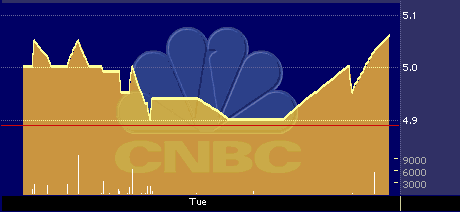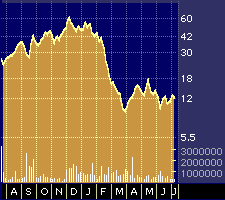
Investors Bid New Issue Imanage up Sharply
Investors Bid New Issue Imanage up Sharply
by Hal Plotkin
Silicon Valley Correspondent
Investors have bid up Imanage Inc. {IMAN} sharply, with the stock opening at $20. The company’s 3.6 million shares were priced at $11 late Tuesday, above the company’s stated range of $8 to $10.

IMAN post-IPO performance chart
San Mateo, Calif.-based Imanage, founded in October 1995, provides Web-based content-management tools that enable businesses to track, store, monitor, and retrieve documents and records that aren’t usually included in traditional database products sold by more-established firms such as IBM {IBM} and Oracle Corp. {ORCL}.
“Imanage is an early mover with a best-of-breed product,” says Hadley Reynolds, director of research at the Delphi Group, a software-industry research firm based in Boston. “They have a chance to come in early and get a few feet of shelf space before others can put something there.”
“Our content-management system goes beyond electronic documents to all other types of media,” says Owen Carton, Imanage’s vice president of marketing. “We integrate all other forms of information, including faxes, voice mail, and e-mail, in one common data store.”
Imanage’s software also includes security protocols that prevent unauthorized individuals from viewing or altering the archived material.
The company, bolstered by an alliance with EDS’ Washington-based Enterprise Information Systems business operation, is experiencing rapid sales growth. Customers include San Francisco-based Charles Schwab Corp. {SCH}, which recently switched from another vendor.
“The decision to switch to iManage was easy,” says Zachary Steele, Schwab’s senior information-technology manager. “iManage has successfully implemented a highly reliable content-management system and has an excellent reputation when it comes to customer satisfaction and service,” Steele said when Imanage made the sale last March.
Imanage’s revenue has surged over the first six months of this year, surpassing $7.8 million, up from $2.2 million for the same period last year. While revenue is growing at a fast clip, losses appear to have stabilized. The company posted a loss of slightly more than $2.1 million for the first half of 1999, essentially unchanged from the year-earlier period.
“We’re not bleeding cash,” says Max Panjwani, Imanage’s president and CEO. Instead, the company president says strong sales “mean we’re adding cash.”
Even so, at least one analyst says the company faces anything but clear sailing.
“They are in one of the most confused and competitive marketplaces,” says Harley Manning, research director at Forrester Research, based in Cambridge, Mass. “Everyone from Microsoft Corp. {MSFT} to big document-management companies to other start-ups are all targeting essentially the same market,” he says.
It’s a point Imanage didn’t gloss over in its IPO filing, called an S-1.
“We expect that competition will increase in the near term and that our primary long-term competitors may not have entered the market yet,” the company says. Imanage goes on to list a wide range of current and potential competitors, including San Jose, Calif.-based Agile Software Corp. {AGIL}, and Documentum Inc. {DCTM}, based in Pleasanton, Calif.
“There are some other very strong companies in the market with growing customer lists,” Manning says.

AGIL Post-IPO Stock Chart

DCTM 52-Week Stock Chart
Other competitors include San Jose, Calif.-based BackWeb Technologies Ltd. {BWEB}; Open Text Corp., based in Canada; and Waltham, Mass.-based Arbortext. Most competing companies address the market in slightly different ways. Some, for example, emphasize internal corporate document-management systems, while others focus on Internet-based content-management systems.
At present, Imanage wins plaudits from analysts such as Reynolds for combining both of those functions in a simple, easy-to-use product that incorporates all kinds of documents.
Manning, however, says a raft of other companies are already eyeing the same opportunity. “The market space is loaded with people who have figured out exactly the same thing,” he says. “It’s a good idea. But there’s going to be a long line of companies doing it.”
Manning is, however, generally optimistic about the business segment targeted by Imanage and similar firms. “It’s an incredibly under-penetrated market right now,” he says, estimating that 70 percent, or more, of the market remains untapped.
And that fact, Reynolds says, gives Imanage a chance to get a sizable jump start, perhaps as much as 24 months, on its largest potential competitors.


